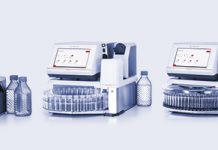Loss on Drying is a back-weighing application to determine the amount of volatile matter in tablets, capsules, or bulky material. Samples are weighed before and after treatment, and the weight difference is measured.
According to the US Pharmacopoeia Chapter 731 (USP Chapter 731) 1–2 g of sample is mixed; for large particles the size is reduced to about 2 mm by quickly crushing. If tablets are to be tested, the powder of not less than 4 tablets must be used; For capsules, the mixed contents of not less than 4 capsules must be used. A glass-stoppered, shallow-weighing bottle that has been dried for about 30 minutes and cooled to room temperature in a desiccator is tared, the sample placed in the bottle, and the initial sample weight is measured. The sample is evenly distributed in the bottle by gentle shaking, the stopper is removed, and the bottle placed in a drying chamber to be incubated at elevated temperature. After heat treatment, the bottle is closed promptly, cooled down in a desiccator to room temperature, and then the back weight is measured.
According to USP the “dry to constant weight“ or according to European Pharmacopoeia (PhEur) the “dried to constant mass” or “ignited to constant mass” weight value of pharmaceutical products is to be measured. The USP defines that two consecutive weighings must not differ by more than 0.50 mg per g of sample, whereas the PhEur specifies that two consecutive weighings must not differ by more than 0.5 mg to consider the sample as dried to constant weight or mass. If the measured weight difference is out of the allowed limits, the drying shall be continued and the weight measured again.
In the Cubis® II software application for loss on drying, the administrator selects between the test procedure according to USP or PhEur, and the sample type – tablet or capsule. Due to the different definition of allowed weight difference, the selection between USP and PhEur determines the mode, or how the software application considers samples to have passed or failed the test.
First the initial sample weight (with tare) and then up to three back weights are measured. In total, ten batches with up to 100 samples each can be processed. The software application calculates the difference between the initial and back weight for each sample, and determines if the weight difference is within the range allowed by USP Chapter 42 <731> or European Pharamacopoeia (PhEur). After weighing back a sample, the software evaluates the weight difference and, if it is out of limit, displays a corresponding message to the user. By this mechanism the user gets a direct feedback when the volatile matter of a sample is too high and the drying process must be prolonged.
The software application for each sample creates a comprehensive report, inclusive of the measured initial and back weight(s), and records if the test was passed or failed according to the applied pharmacopoeia.
The Cubis® II software application Loss on Drying guides the user through the backweighing process and automatically evaluates the results according to USP or PhEur. If a test for a product fails the user gets a corresponding message displayed that cannot be overlooked.
The Cubis® II balance is a perfect solution for your applications in the chemical composition analysis.
application highlight
sartorius.com/cosmetics-personal-care









